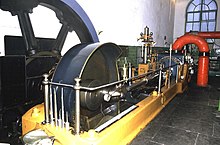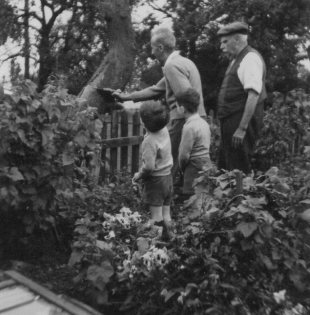
Tom Jackson in his 20s
17 December 1872. My grandfather, Thomas Jackson (after whom I get my middle name), was born on this day 150 years ago, at 11 Duke Street, Burton upon Trent, Staffordshire, the second son and child of William Jackson, a brewer’s laborer (1839-1888) and his wife Harriet née Bailey (1842-1884).
He had an older brother George (1870-1950) and a younger sister Annie (1877-1913).

11 Duke St, Burton upon Trent today.
He was the 4th great-grandson of John Jackson (my 6th great-grandfather), who was born around 1711 towards the end of the reign of Queen Anne¹.
When I was born in November 1948, Grandad was already an old man, approaching his 76th birthday, older by two years than I am today.

With extended Jackson family in 1949. I’m the babe-in-arms on my mother Lilian’s knee! My eldest brother Martin is sitting on the ground in front of Mum and me, elder brother Edgar is next to Grandad, and my sister Margaret is sitting next to Grandma. My father Fred is standing at the rear, on the right, next to his brother-in-law, Cyril Moore.
My grandparents lived in Hollington (a small village between Ashbourne and Derby) at Ebenezer Cottage, the venue for many family get-togethers.

Ebenezer Cottage, probably in the summer of 1939, maybe 1940.
The photos below, of a picnic in Hollington with Grandma and our Paxton cousins (who lived across the road from my grandparents) was taken in the early 1950s. Visits to Hollington weren’t frequent. My dad didn’t have his own car, just occasional recreational access to the Morris pickup he used as staff photographer for The Congleton Chronicle newspaper. In any case, I was very young so don’t remember too well.
After we moved to Leek (12 miles closer to Hollington) in 1956, Dad set up his own photography business, and bought a secondhand car (often quite unreliable). But it did mean that we could visit our grandparents more often and meet other members of our wider Jackson family. And, from time-to-time, we stayed overnight with my grandparents. I loved sleeping in the bedroom under the eaves.
Anyway, I’m getting ahead of myself.
On 4 September 1897, Tom (then aged 24) married his first wife Maria Bishop (aged 23) in Burton upon Trent. They had two children: Alice, born on 28 September 1899, and a son, William, born on 15 November 1902. Sadly, Maria died in childbirth, leaving Tom a widower, aged 29, with a three-year old daughter and a baby to look after. His mother-in-law, Emma, was living with the family at that time.
Two years later, on 23 August 1904 he married for a second time, to Alice Maud Bull (my grandmother) at Longford, just south of Hollington where Alice was born in April 1880.
Tom and Alice had four children: Winifred Annie (always known as ‘Wynne’, 1905-2004), Frederick Harry (known as ‘Fred’, my father, 1908-1980), Edgar Albert (1914-1997), and Rebecca Isabel (known as ‘Becky’, 1916-2013).

L to R: Grandad, Alice, Frederick, Winifred, William, Edgar, and Grandma – in about 1915.
Before 1908, the family had moved to 31 South Oak Street in Burton, and remained there until March 1939 when they purchased Ebenezer Cottage in Hollington.

31 South Oak Street today.
In August 1954, Grandad and Grandma celebrated their Golden Wedding anniversary with family and friends in the village hall.

Tom and Alice Jackson with all their children and grandchildren, with the exception of the youngest (Angela) who wasn’t born then. Grandad is holding cousin Timothy, and Grandma holds his sister Caroline, youngest children of Edgar. I’m sitting on the ground at left.
In 1963, they sold Ebenezer Cottage and moved to live with their elder daughter Wynne and husband Cyril in Woodville, Derbyshire. It was there in August 1964 that they celebrated their Diamond Wedding anniversary.


Tom and Alice with some of their children and grandchildren on their Diamond Wedding.
Grandad died on 26 February 1967, aged 94. Grandma, a widow at 86, survived Tom for another 20 months, passing away on 7 November 1968 after suffering a cerebral thrombosis.
I don’t know too much about my grandad’s early life. He was profoundly deaf for many years, but I don’t when that first affected him. I always believed he went deaf as a young man, but we have a photograph of him as a member of the Christ Church Band (a parish in Burton which encompassed Duke Street) in 1898 so presumably was not deaf then.

Tom Jackson is second from the left, front row, holding a flute.
He began his working life as a brewer’s laborer (certainly by 1891) at one of the breweries in Burton, Worthington & Co., and stayed with them throughout his working life.

A stationary steam engine
When he married Maria Bishop in 1897, he was a ‘fireman’, presumably the person who stoked the boiler to power a stationary steam engine (similar, it’s safe to assume, to the one illustrated here) the source of power for the brewery. In the 1901 census, Tom was listed as a ‘stationary engine driver’ and he continued in that occupation until he retired in 1931, aged 59.
I can only surmise that his deafness came about as a workplace-acquired disability, having been exposed daily to the noise of the steam engine and other machinery. No Health & Safety back in the day, and no obligation presumably or workplace support to wear ear protectors.
He didn’t serve in the First World War. At the beginning of the war he was already 41, and probably deaf by then, exempting him from active service.
During the Second World War, Mum spent two periods with Grandad and Grandma in Hollington while Dad was away serving in the Royal Navy. With her were my eldest brother Martin (born just three days before the declaration of war in September 1939) and sister Margaret (born in January 1941).
I still have a vivid image of Grandad sitting in his armchair in one corner of the parlor, often with a cigarette dangling from his lips while he dozed. My cousin Jean Gould née Paxton (daughter of his eldest daughter Alice) captured him like that in this painting.
Also, hanging from the key on his desk, are the headphones he used to listen to the radio. And to his left side the grate that my grandmother cooked on. There was no electricity nor running water in Ebenezer Cottage. Water was drawn from a well in the front garden of the house next door – Rose Cottage where Grandma was born.

Rose Cottage, Hollington with the more recent extension to Ebenezer Cottage in the left background.
There was a cinder toilet down a short path outside the back door. And while both water and electricity were eventually installed before they moved to Woodville, the sanitary arrangements remained the same.
When Grandad was dozing in his armchair, we were always warned not to disturb him, not even knock his chair. If we did, he’d wake up, not in the best of moods.
There’s an anecdote, from November 1944, when Grandad was woken from his slumbers. I’m not sure if Martin told me this, or it was Mum. Anyway, on that particular day—the 27th—Grandad was apparently jolted awake and immediately thought the children were playing around his chair. Not so!
Just after 11 am, and 8 miles south from Ebenezer Cottage as the crow flies, an underground ammunition storage depot at RAF Fauld exploded, with between 3900 and 4400 tons of high explosives going up. This was one of the largest non-nuclear blasts in history and the largest in the UK. Grandad had been woken by the blast and shock wave from that explosion.
Grandad was a keen gardener, proud of his roses, vegetables, and fruits (particularly gooseberries, raspberries, and blackcurrants).
On the front of the cottage there was a climbing Peace rose to the left of the front door, and a Victoria plum on the right (facing the building). It was always a contest, around August, as to who would get to the delicious plums first: us or the voracious wasps? At one end of the cottage, there was a beautifully-scented lilac tree. In January/February the garden either side of the front steps was covered in snowdrops.
At the bottom of the garden were a couple of damson trees. In the photos below, it looks like Grandad and my Dad are pruning these trees, with a little ‘help’ from Edgar and me. In his memoir Gathering No Moss (completed just before he died in 1980) my Dad tells of being docked a week’s leave while in the Royal Navy for overstaying his leave in Hollington by two days to help with the ‘damson harvest’. This was during the period in 1945 after the end of the war while he waiting to be demobbed.
In the summer I often enjoyed sitting on the steps outside the front door in the late afternoon, anticipating the herd of cows being driven to Hammersley’s farmyard next door for milking.

With my elder brother Edgar and cousin Diana (daughter of Wynne and Cyril) with Grandma and Grandad, late 1950s. Mum and Dad are in the lower photo.
Grandparents, Hollington, and Ebenezer Cottage feature heavily in my childhood memories. Remarkable to think that today we celebrate Grandad’s birthday, 150 years on.
¹ I am grateful to my elder brother Martin for much of the information I have used in this blog post. After the death of our father in 1980, Martin began to research our family’s ancestry, and on some lines has been able to find direct links to the late 15th century. He has compiled the enormous amount of data in this fascinating website: http://www.clanjackson.co.uk/genealogy/

















 Just plotting their birthplaces on a map (it’s the geographer in me) gives me a sense of belonging. At heart, I am a
Just plotting their birthplaces on a map (it’s the geographer in me) gives me a sense of belonging. At heart, I am a  Clickety click? You play bingo, don’t you? It’s the 66 ball.
Clickety click? You play bingo, don’t you? It’s the 66 ball.

































































 In fourteen hundred ninety-two
In fourteen hundred ninety-two
 In 1483, Edward IV died and the crown was usurped by his youngest brother, Richard, Duke of Gloucester, who became the notorious (if we are to believe Tudor propaganda)
In 1483, Edward IV died and the crown was usurped by his youngest brother, Richard, Duke of Gloucester, who became the notorious (if we are to believe Tudor propaganda)  When my 8th great grandfather Robert was born in
When my 8th great grandfather Robert was born in 









